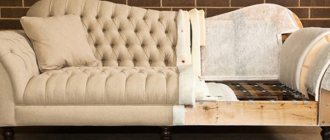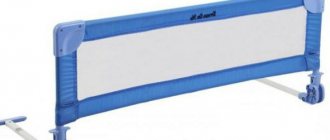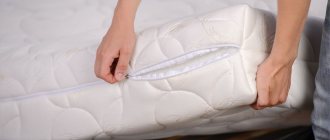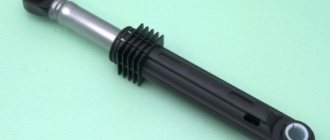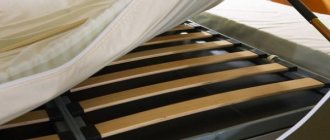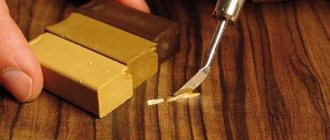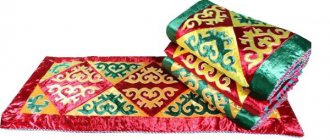- home
- Author's articles
- Useful articles
A mattress is a soft bed base that can be with or without a frame. It comes in several types, but in everyday life, only two are most often used - spring and stuffed. In our article we will talk specifically about spring types, which, in turn, are divided into two types.
- With a continuous weave of springs called Bonnell
- With independent blocks of springs, which are considered orthopedic
The first type is more common. It is inexpensive, so it is very popular. The second type has greater capabilities, but is also more expensive. In any case, the subject of discussion consists of a spring block or shock-absorbing parts, a hard layer, a cover and a filler. The latter can be both soft and hard. As for the covering, it is better that it be made of natural fabric.
How the mattress works
A mattress with dependent springs consists of a metal frame on which springs are installed, rigidly fastened together and forming a single block.
The structure of a mattress with dependent springs
The most common is the Bonnell spring unit, invented more than 150 years ago, which contains from 120 to 160 springs per square meter. The spring consists of coils of different diameters - maximum at the edges and tapering towards the center. Thanks to this, they do not rub against each other and do not make increased noise.
Mattress based on Bonnell dependent spring block
The most common are five-turn steel springs made of hardened wire; four-turn springs are less commonly used. Dependent spring blocks are used in the production of upholstered furniture - sofas, ottomans, and are also produced for the production of mattresses for beds.
This block system consists of spring elements of a special cone shape, which are fastened together with a spiral wire made of hard carbon steel
This type of mattress is still in great demand among buyers due to its practicality and durability. The cost of this product is 30–40 percent lower than independent spring mattresses.
In a mattress with independent springs, which are called orthopedic, the springs are in covers made of non-woven material, which are glued together into a single block.
Bed mattress based on an independent spring block
With this scheme, the load is distributed more evenly, which allows the body to take a natural position when sleeping.
In this system, each spring element in the shape of a cylinder or “barrel” is located in its own special case made of thick fabric or elastic materials
An orthopedic mattress prevents the occurrence of back diseases, the sleeper’s blood circulation is not impaired, and a person wakes up in the morning rested, without pain.
Independent spring block for orthopedic mattresses
The greater the number of springs used per square meter, the more pronounced the orthopedic effect.
There are 3 types of hardness:
- high, recommended for weights over 95 kg;
- average, weight from 60 to 95 kg;
- soft, weight up to 60 kg.
According to the number of springs, mattresses are divided into:
- multipack TFK, with 250 springs. per square meter;
- multipack S 1000–500 pcs.;
- multipack S 2000– 1000 pcs.
Types of springs for independent blocks
Types of faults
There are two types of spring mattresses: with an independent spring block and with a continuous weave of springs. Modern orthopedic mattresses in most cases are equipped with separate blocks of springs; continuous weaving is found in old-style mattresses.
During repairs, the user may encounter various breakdowns:
- the need to replace external upholstery or sealing material;
- disconnecting the spring from the base;
- deformation of the spring block;
- cracks in the mattress frame.
A number of tools are required to carry out the work:
- hammer and pliers;
- nails (regular 50-60 mm and furniture);
- clamps;
- stationery knife or scissors;
- needle and strong thread (preferably regular thick or silk);
- sealing material – synthetic winterizer or foam rubber;
- durable cord (recommended thickness 5 mm);
- manual or electric stapler, staples;
- spare springs.
Devices with continuous weave springs
In this case, we are talking about a standard product, which contains a block with independent springs. Let's consider the main features of such accessories:
- Such an orthopedic mattress has a long service life.
- The load is distributed evenly across all elements.
- Damage to an individual spring does not lead to loss of functionality of the remaining springs.
- There is no standard alignment and fastening.
- The springs are mounted directly to the frame.
- Repairs do not require complete removal of the casing.
- Built-in elements are not very expensive.
- You can repair such a mattress yourself.
As a rule, restoring such a mattress with your own hands involves identifying the fault, gaining access to the problem area, removing the component and installing a new device.
Important. Despite the widespread use of such devices, they quickly lose elasticity under the constant influence of heavy load on a certain area.
Recovery instructions
In order to properly repair the accessory, it is necessary to carry out repair work in accordance with the following step-by-step algorithm:
- All elements must first be cleaned;
- Next, a thorough inspection of the device is performed;
- components are checked for functionality;
- the rack fastening is removed;
- the spring is being knitted or replaced;
- the device is assembled in reverse order;
- The product is re-plated.
Necessary materials
The choice of tools depends on the cause of the damage. To replace the upholstery by hand, all you need is glue and a matching fabric. If the integrity of the springs is damaged, you will have to stock up on new parts. The main things you will need during a major overhaul are new upholstery, a hammer, and nails.
You'll need:
- furniture stapler;
- elastic cord;
- filler (foam rollers);
- decorative cladding;
- lining (any breathable and durable fabric);
- slats (7 x 2).
When troubleshooting, it is important to also have pliers and wire on hand. All work is divided into several stages. First, the mattress is disassembled, then new springs are installed, the binding is made, and finally the product is sheathed (assembly).
Disassembling the mattress
The best place for repairs is a barn or other non-residential premises. During the period of operation, dust and particles of debris accumulate inside the product. Therefore, a good option is to use a vacuum cleaner when working.
First, the mattress is turned over with the outer surface down. Position it to ensure a flat surface. To make it easy to approach the mattress from each side, it is placed on four stools. Next, carefully free the product from its contents: remove old nails, remove paper clips with pliers, remove the decorative fabric of the upholstery and take out the soft rollers.
Sheathing of the product
The final stage of repair is reupholstering the mattress with outer upholstery. To do this, first cover the spring block with a lining. The material must be dense, for example, tarpaulin (burlap or dermantin is also suitable). So, the lining base is placed on top of the spring block and secured with it with a regular stapler.
Then take a sealant (foam rubber, padding polyester). These rollers are placed on the lining in selected places. This ensures high-quality styling. The top of the mattress product should be covered with decorative fabric, and the edges of the upholstery should be carefully tucked inward.
What is a spring mattress made of?
Composition of a mattress with a Bonnell spring block
The mattress consists of the following elements:
- spring block;
- an underlying layer of non-woven material or burlap;
- sealing layer, materials used – heat-pressed felt, coconut coir, polyurethane foam (foam rubber), struttofiber, latex, highly elastic foam;
- The top layer is a cover, made of natural fabrics - linen, cotton.
Composition of a spring mattress with an independent block
Summing up
Do-it-yourself spring mattress repair is cost-effective. If you approach the repair of an old Bonnell-type mattress meticulously and thoroughly, the final result may surprise you.
If the mattress is badly damaged or you are categorically not satisfied with its characteristics, it is better to look at a more modern option, for example, a model with a block of independent springs.
Stages of the recovery process
Lack of skills in restoring spring mattresses is not a reason to refuse to do it yourself, especially... if you want to get down to business! By deciding to restore the product yourself, you can significantly save money, which would be better spent on purchasing materials for repairing a sofa or mattress. And you will definitely need them. You may need:
- Construction staples, nails, stapler, hammer
- Strong twine for tying (not jute, but synthetic!)
- Sheet of filler material to replace the interlayer (PPU, coir, struttofiber)
- Cushioning material placed between the spring block and the filler layer (non-woven fabric, spunbond, linen, hard felt)
- New upholstery fabric for exterior cover (as needed)
- Wood slats
- Springs
From the list-list, new springs are usually the hardest to find. The reason lies in the block production technology. The name of the design explains it: a block with continuous weaving. The production and assembly of blocks is carried out in factories and not manually, but on automatic and semi-automatic devices. Therefore, it is problematic to find separate springs for such a block on sale.
If you don’t have contacts at the Bonnell block factory, you can use intact elements from another mattress to replace one or more springs.
Stage 1. Disassemble the mattress - assess the situation
Please note that over the years of use, a large amount of dust has accumulated in the mattress. Therefore, it is better to disassemble the product outside the home. Dismantling work can be carried out in the garage, at the dacha or directly on the street.
- Before you begin, thoroughly vacuum the upholstery and assess its condition - whether it can be reused or not.
- Place the mattress on a table or four stools with the base upside down.
- Next, depending on the decision made regarding the future “fate” of the outer skin, choose a method for removing it. If the fabric cannot be reused, you can simply tear it off with sharp movements, then fold it and throw it in the trash. If you decide to keep the upholstery, wash it and reuse it, you will have to approach the removal more carefully (without tearing it off, but removing each fastening bracket or nail individually). Important! Be careful when dismantling old fittings. In order to later install it in its original place without any problems, you can make notes along the way with a marker.
- Next, we evaluate the condition of the flooring (the soft layer between the spring block and the outer skin). Most likely, it will be discovered that the service life of the layers of flooring (felt, foam rubber) has long been exhausted and requires immediate replacement.
- After removing the flooring, carefully vacuum the spring block inside.
- We inspect the side frame (if there is one).
- We inspect the base (bottom).
Advice! If in the design of your mattress the role of the base is performed by belts, bodice or elastic rubber bands, it is better to replace them with wooden slats. To do this, prepare wooden slats of the required size. The slats should be secured in the same places where the tapes were attached.
Stage 2. Assess the complexity of damage in the spring block
After dismantling the main parts, you can proceed to assessing the condition of the spring block. Carefully inspect it for dents, weakened or burst springs. Since the unit with the dependent system was not made manually at the factory, the word “repair” will rather mean a number of life hacks and tricks. The real repair of the Bonnell block (in the case of burst or severely deformed springs) consists of its complete replacement. If this is not possible, you will have to tinker with replacing individual elements.
Reference! If the spring block is seriously damaged, you can save time and simplify the task by replacing the spring block with a springless filler. Getting PU foam for a mattress today is not a problem. The main thing is to take time and understand the brands in order to buy material of sufficient density and rigidity.
Stage 3. We tie the springs
If the spring block is not damaged, the wooden frame and base are intact (or can be repaired), and the problem is mainly sagging, the solution will be the proven “old-fashioned” method - tying the springs. This technique will allow you to “pull” weakened springs to a common level, level the plane, give elasticity to the mattress and extend the life of the product.
Reference! The springs are tied using durable synthetic twine.
- We hammer construction staples into the top slats of the side frame (if the frame is wooden) (not completely) opposite the rows with springs. It is to these “loops” that the binding cord will be attached (at the beginning and at the end of each row of springs) to secure the harness to the frame.
- Next, we proceed to tying the transverse (short) rows.
- Then we move on to long longitudinal rows.
- Finally, we perform a diagonal strapping. Important! As you proceed with the strapping work, make sure that the height of the springs is the same (in sagging areas, pull the twine tighter). At the same time, the cord tension should not be too tight. The harness should not pull the springs too tightly together. It is important to catch and feel the tension.
- At the end, we hammer in all the staples on the wooden frame (through which the twine is threaded) until they stop.
Stage 4. Restoring the springs
If, after opening the casing, it turns out that the springs are broken, you cannot do without replacing the elements. If one or two springs are broken, it is enough to replace only them. Unfortunately, as a rule, in blocks of old mattresses you can find entire rows of broken springs in the central part of the mattress (the part that was subjected to the greatest stress). There are two options to solve the problem.
- Complete replacement of the spring block. This method is more reliable and simple, but requires the presence (or purchase) of a similar working unit.
- Partial block replacement. In this case, you will have to dismantle the wooden frame to provide access to the spring rows on both sides. After this, the damaged area is removed and a new one is installed in its place.
Advice! When performing a partial block replacement, cut the edges of the metal spring binding wire that holds the rows of main springs together and unscrew it counterclockwise. After removing the old one and installing the new element into the block, screw it back in.
Stage 5. Restoring the casing
To upholster (cover) a sofa or frame mattress accurately, you will need a furniture stapler.
- First we lay the substrate, the so-called “drum”. Reference! This is a fabric (you can use the old one), which is stretched directly onto a spring block and secured with a stapler to a wooden frame.
- On top we lay a softening layer (or several) - polyurethane foam, coir.
- To prevent the wooden frame from breaking through the new fabric, we put padding polyester (thin foam rubber) on the corners of the slats. This will also add comfort while sitting on the mattress.
- Lastly, we cover the repaired product with furniture fabric.
- If the bottom of the mattress was sewn with a backing, install it in its original place.
Repair of mattresses with spring blocks
The service life of spring mattresses is 8–15 years. But sooner or later the question of replacing or repairing it arises. In some cases, it is preferable to repair the mattress and save 30–40 percent of its cost. What is mattress repair?
Over time, the highest quality mattress loses its properties - dips appear, springs burst, shape changes, the covering fabric becomes frayed and dirty.
In this case, there are two ways - buying a new mattress or repairing the old one.
The easiest way is to contact a mattress reupholstery workshop, where specialists will carry out a comprehensive repair of your product, replace the entire spring block, or, if there are only a few damaged springs, replace individual elements. A mattress that has undergone high-quality repairs in a workshop is not inferior in its properties to a newly purchased one.
Tools needed for repairs
The choice of tool depends on the damage to the mattress. If you need to replace the upholstery, you will need glue and a fabric of suitable size and structure that will not tear after several months of use. If the problem is in the metal structure, you will have to buy new springs to repair the mattress.
Materials and tools that may be needed for repairs:
- Metal wire or elastic cord.
- A backing that can be used with any durable and breathable fabric.
- Wooden slats 70×20 mm.
- Decorative cladding.
- Nails, hammer.
- Furniture stapler.
- Decorative cladding.
- Thread, needle or sewing machine.
- Glue gun.
- Scissors.
- Pliers.
Repairing or restoring a spring mattress for a bed with your own hands involves: removing the upholstery material, replacing the necessary elements, tying the springs and final covering.
Fastening
The stage that requires the most effort and time. It includes several steps:
- checking the serviceability of parts;
- frame installation;
- spring binding.
First, remove the cord connecting the springs and remove the nails from the frame. Then you need to inspect the springs and return them to their original position. Broken parts are thrown away and new ones are installed. To do this, the springs are nailed to the slats using nails that are bent inward. It is first recommended to make precise markings on the body of the product.
It should be taken into account that in orthopedic mattresses the individual springs are located in special bags
. And in conventional ones there are three methods of fastening:
- using wooden slats. Sometimes it is enough to simply hammer a loose part;
- the use of fabric straps over wooden slats;
- fabric belts. They give the mattress orthopedic properties.
If fabric straps were used in the manufacture of the mattress, you will need to cut out the wooden slats yourself. Elastic fabric straps are attached to them. The length of the slats should correspond to the width of the mattress.
To replace the spring bag in orthopedic models, you will need an element with new springs. It is sewn in using a regular needle and strong thread.
Harness
After checking and securing the springs, the strapping process is carried out. For this purpose you will need a strong rope (diameter about 3 cm). First, take nails and drive them opposite a separate spring row. Then the nails are bent to create peculiar hooks. The cord will be wound around them.
First of all, you need to deal with tying the transverse springs. Each spring is processed separately with a cord. Then they begin to tie the elements in the longitudinal direction. For efficiency reasons, they are fastened with transverse ones.
Finally, the springs are processed diagonally. The angle with respect to the previous harnesses should be 45 degrees. At the end of this work, the nails left by the hooks are completely bent.
Stage 1: Removing the upholstery and cleaning
Experts recommend repairing a mattress outside or in a garage, but if this is not possible, it is permissible to do it at home. The entire structure should be placed on a flat horizontal surface or several stools so that the structure can be approached from any side.
In most cases, the top decorative cover is closed with a zipper along the entire perimeter; it is easy to remove and remove the structure itself. If the outer material is stitched, it should be ripped apart; it is not necessary to cut all the seams; it is enough to separate the parts of the cover on one side. Then carefully remove the sealing and cushioning fabric that covers the springs.
In modern mattresses, the lining fabric is glued with strong glue. To remove it, carefully cut the glued seams with a sharp knife.
If the mattress has been in use for a long time, a large accumulation of dust may form in it, which should be removed with a household or car vacuum cleaner. At this stage, you should thoroughly clean all parts of the mattress. If the sealing and lining material has become unusable, it is recommended to replace it with a new one or wash it.
Reasons for repairing mattresses
The main reasons why it is easy to understand that a product requires restoration can be included in one list. If the following problems are addressed in time, the mattress will last longer. Restoration is required when:
- The casing is damaged;
- The springs were deformed;
- The filler is worn out;
- The structure was broken.
Also, during a preliminary inspection, you can find other troubles that can be easily eliminated with repairs.
Repairing mattresses at home as a business
To start a mattress repair business at home, you don’t need to have a lot of start-up capital. But before you start working in this service sector, you need to analyze the demand market in your region and determine the percentage of competitive entrepreneurs.
The main costs will be associated with registering an individual entrepreneur, purchasing consumables and tools necessary for work. It is better to buy upholstery fabrics, fillers, substrates and shock-absorbing elements at wholesale stores or from manufacturing plants.
The principles according to which our masters work:
- Professionalism. Our craftsmen are constantly engaged in self-improvement, which is why they provide the best repair of air mattresses in Moscow.
- Experience. In order to properly repair a mattress, you must have extensive experience working with such things. All our masters have been repairing various mattresses for several years now. That is why our technicians can fix any problem.
- Speed. We quickly carry out all repair work.
- Reliability. Many people are afraid to send their items to workshops because they are afraid that their products will be damaged. You can easily call a specialist to your home, they will repair the mattress at home. You can be confident in the reliability of our craftsmen.
Repairing mattresses in our workshop will not take much time, everything will be done quickly and efficiently, because we have the best professional craftsmen who can carry out any repair work, even the most complex. So if you notice any problem with your mattress, immediately bring it in for repair. In our workshop it will be executed in the best possible way. You shouldn’t put off repairing your mattress, because the sooner you solve this problem, the cheaper it will cost you. After all, if you solve the problem initially, when it first appears, you can avoid further breakdowns, the repair of which will take longer and be more expensive. So learn to fix breakdowns right away.


